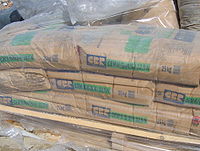
Photo from wikipedia
Abstract Sulfate attacking to the marine concrete is detrimental to the material durability. To better understand the sulfate attacking mechanism, 29Si and 27Al MAS NMR spectroscopy combined with SEM-EDS techniques… Click to show full abstract
Abstract Sulfate attacking to the marine concrete is detrimental to the material durability. To better understand the sulfate attacking mechanism, 29Si and 27Al MAS NMR spectroscopy combined with SEM-EDS techniques were utilized to investigate the microstructure of Portland cement paste (PC) and PC with granulated blast furnace slag (PC-GBFS) curing in both water and the sulfate sodium solution during 365 d. When the PC hydrated in sulfate sodium solution, the Ca/Si ratio reduces from 2.33 to 1.88 and the mean length of aluminosilicate chains for the C-A-S-H gel is elongated by 27.49%. It means that the sulfate ions de-calcificate the calcium ions in the C-A-S-H gel, enhancing the polymerization of its silicate tetrahedra. Meanwhile, Al[4]/Si ratio decreases from 0.026 to 0.011 and plenty of ettringite was also observed in the cement paste hydrating in sulfate sodium solution. Sulfate ions reacted with the aluminate species in the C-A-S-H gel, producing the ettringite crystal. On the other hand, the incorporation of GBFS in PC paste can reduce the effects of de-calcification and de-alumination significantly, effectively preventing the secondary formation of ettringite, and hence improving the stability of silicate-aluminate skeleton in C-A-S-H gel. Furthermore, molecular dynamics study was carried out to characterize the interaction between sulfate ions and C-A-S-H gel at a molecular scale. The sulfate ions carried interface Ca2+ ions into the pore solution to form ionic clusters of Ca-SO4, leading to the decalcification of C-A-S-H gel. The C-A-S-H structure with intact aluminosilicate chain structure and low Ca/Si ratio in PC-GBFS has more stable Si-O-Ca bonding and the Ca ions can remain in the C-A-S-H gel for longer time.
Journal Title: Construction and Building Materials
Year Published: 2018
Link to full text (if available)
Share on Social Media: Sign Up to like & get
recommendations!